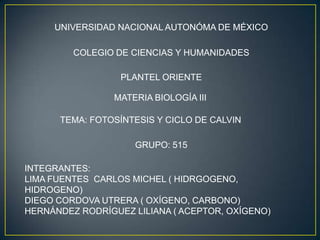
La fotosintesis
- 1. UNIVERSIDAD NACIONAL AUTONÓMA DE MÉXICO COLEGIO DE CIENCIAS Y HUMANIDADES PLANTEL ORIENTE MATERIA BIOLOGÍA III TEMA: FOTOSÍNTESIS Y CICLO DE CALVIN GRUPO: 515 INTEGRANTES: LIMA FUENTES CARLOS MICHEL ( HIDRGOGENO, HIDROGENO) DIEGO CORDOVA UTRERA ( OXÍGENO, CARBONO) HERNÁNDEZ RODRÍGUEZ LILIANA ( ACEPTOR, OXÍGENO)
- 2. LA FOTOSÍNTESIS • CARACTERISTICAS GENERALES • LA FOTOSINTESIS ES UN PROCESO POR EL CUAL LAS PLANTAS, ALGAS, CIANOBACTERIAS Y ALGUNAS BACTERIAS FABRICAN SU PROPIO ALIMENTO, VALIENDOSE DE LA LUZ SOLAR (ENERGIA LUMINICA), DIOXIDO DE CARBONO, CLOROFILA Y AGUA.
- 3. • EN ESTE PROCESO HAY DOS ETAPAS: LUMINICA Y OSCURA • LUMINICA • LA ENERGIA SOLAR ES APREHENDIDA POR LA CLOROFILA (PIGMENTO VERDE), SE ROMPEN LAS MOLECULAS DE AGUA, SE ALMACENA ENERGIA EN MOLECULAS DE ATP.
- 4. • FASE OSCURA • SE USA BIOXIDO DE CARBONO Y SE FORMA LA GLUCOSA, CON LA AYUDA DE LA ENERGIA OBTENIDA DEL ATP Y EL NADPH2 • OCURRE EN EL ESTROMA DE LOS CLOROPLASTOS • ESTAS REACCIONES INCLUYEN UNA SERIE DE REACCIONES LLAMADAS EL CICLO DE CALVIN.
- 5. • EN RESUMEN, EN EL CICLO DE CALVIN SE ABSORBE EL CO2 CONVIRTIENDOLO EN CARBOHIDRATOS • CABE RECALCAR QUE LA ENERGIA DE LA LUZ ES NECESARIA PARA LA FOTOSINTESIS • ESTA ENERGIA SE PROPAGA EN FORMA DE ONDAS • PARA SINTETIZAR EL ALIMENTO, LOS AUTOTROFOS USAN UNICAMENTE LAS ONDAS DE LUZ.
- 6. REPRESENTACIÓ DE LA FOTOSÍNTESIS PASO 1: EN ESTA REPRESENTACIÓN TRATAMOS DE REPRESENTAR LO QUE OASA EN EL PROCESO DE LA FOTOSÍNTESIS. PRIMERO EL FOTÓN ENTRA AL CITOPLASMA Y LA CLOROFIALA QUE ESTA UNIDA A UN ELECTRÓN NEGATIVO TRATA DE ATRAPAR AL FOTÓN QUE ENTRO PERO EL FOTÓ TRATA DE ESCAPAR
- 8. PASO 2: DESPUÉS DE SER EL FOTÓN ATRAPADO POR LA CLOROFILA ESTA LE QUITA LA ENERGÍA Y DE INMEDIATO SE DESINTEGRA DICHO FOTÓN LUEGO LA CLOROFILA EXCITA AL ELECTRÓN NEGATIVO Y LO LIBERA ESTE A SU VEZ SE VA HACIA LOS ACEPTORES DE ELECTRONES DONDE VA EXCITANDO A CADA ACEPTOR Y DICHOS ACEPTORES VAN DANDOLE SU ENERGÍA , DESPUÉS EL ELECTRON ROMPE LA MOLÉCULA DE AGUA
- 10. PASO 3: : Y EL OXÍGENO ES LIBERADO DE LA CÉLULA MIENTRAS QUE LOS HIDROGENOS SON CAPTURADOS POR LOS NAD , DESPUÉS DE EL ATP PASA POR LOS ACEPTORES DE ELECTRONES Y TOMAN LA ENERGÍA QUE ESTOS YA TENÍAN DEL ELECTRON Y EL ATP SE VA AL CICLO DE CALVIN QUE LES EXPLICAREMOS ADELANTE.
- 12. CICLO DE CALVIN PASO 1: DESPUÉS DE LA FASE LUMINOSA QUE FUE LA ANTERIOR VIENE EL CICLO DE CALVIN ( FASE OSCURA) LA CUAL EMPIEZA CUANDO EL CO2 SE INTRODUCE EN LA CÉLULA Y VA HACIA LA ENZIMA LUEGO ESTA ENZIMA ACOMODA AL CO2 JUNTANDO A LOS DOS OXÍGENOS Y DESPUÉS LLEGA EL HIDROGENO CON EL NAD ESTE LO LIBERA Y LA ENZIMA LO UNE CON EL CO2 ,
- 14. PASO 2: DESPUES ACOMODA AL CO2H ATRÁS DE SI MISMA PARA QUE CUANDO LLEGUE EL OTRO CO2 LOS PUEDA UNIR LUEGO LLEGA OTRO CO2 A LA ENZIMA Y TAMBIÉN ES ORDENADO Y UNIDO A UN HIDROGENO LIBERADO LUEGO LLEGA EL ATP CON LA NERGÍA Y SE LA ENTREGA A LA ENZIMA PARA QUE ESTE A SU VEZ PUEDA UNIR A LOS DOS CO2H Y ASI SE PUEDA FORMAR LA GLUCOSA.
